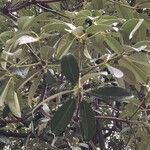Tree up to 40 m high, up to 60(-100) cm dbh, fluted at base and forming tall buttresses up to 8 m high. Bark rough, fissured and peeling off in rectangular flakes, greyish or brownish; inner bark cream, yellow, with copious white latex. Branchlets glabrous. Leaves in whorls of 4-7(-9); petiole glabrous, (7-)10-20(-30) mm long, with a deltoid or scale-like colleter in the axils; blade subcoriaceous to coriaceous when dried, narrowly elliptic to obovate (rarely ovate), 4.5-22 by 2.1-7 cm, 2.2-4.1 times as long as wide, apex obtuse, sometimes shortly acuminate with a blunt acumen up to 0.6 cm long, base obtuse or acute, glabrous on both sides; 30-60(-70) pairs of secondary veins, straight, forming an angle of 80-90° with the midrib, 1-3(-4) mm from each other; tertiary venation from the middle ramified, inconspicuous or almost so. Inflorescence 3-9(-14) cm long, usually forming 2 umbels above each other, many-flowered; pedicels (0-)1-3 mm long, pubescent. Bracts and bracteoles linear or sepal-like, up to 2(-3) mm long, acute, ciliate. Flowers fragrant. Sepals pale green, connate at the base for 0.2-0.6 mm, erect or slightly spreading when dried, ovate, 1.2-2 by 0.7-1 mm, obtuse, sometimes acute, pubescent outside, glabrous or puberulous around the apex inside, ciliate. Corolla lobes sinistrorse; white, yellow or cream, 8-11 mm long in the mature bud and forming a narrowly ovoid head, 3-5 by 1-1.4 mm, glabrous outside; tube 5.6-8 mm long, 1.2-1.8 mm wide around the stamens; lobes oblique, ovate to narrowly ovate or oblong, 4-6.5 by 1.6-3 mm, 1.8-3.3 times as long as wide, densely pubescent at extreme base inside. Stamens inserted at 4.2-5.8 mm from the base; anthers ovate, 0.8-1 by 0.35-0.4 mm, obtuse. Pistil 4.8-6.3 mm long; ovary ovoid or broadly ovoid, 0.8-1.1 by 0.8-1 mm, of 2 carpels, mostly entirely glabrous, rarely sparsely hairy around the apex, with or without a narrow disk-like thickening at the base; style 3.7-5 mm long; style head pagoda shape, 0.5-0.7 mm high, with a short and robust cleft stigmoid apical part 0.2-0.3 mm high. Fruit a pair of follicles, (15-)20-35 cm by 1.6-2.3 mm, brownish tomentose. Seeds dark brown, oblong, 5-7 by 1.3-1.5 mm, minutely undulate and pubescent on the hilar side (except surrounding the hilum which is a glabrous elliptic belt), smooth and glabrous on the other side, ends rounded or obtuse, longest cilia 10-15 mm long.
More
A tree. It grows 45 m tall. The trunk an be 100 cm across. It has buttresses 8 m tall. It has white sap. The leaves are in rings of 5-8. They are whitish underneath. There is no ligule at the base of the leaf stalk. The fruit are long and narrow. They are 30 cm long. They are greenish and hairy. It splits open to show the small seeds.

